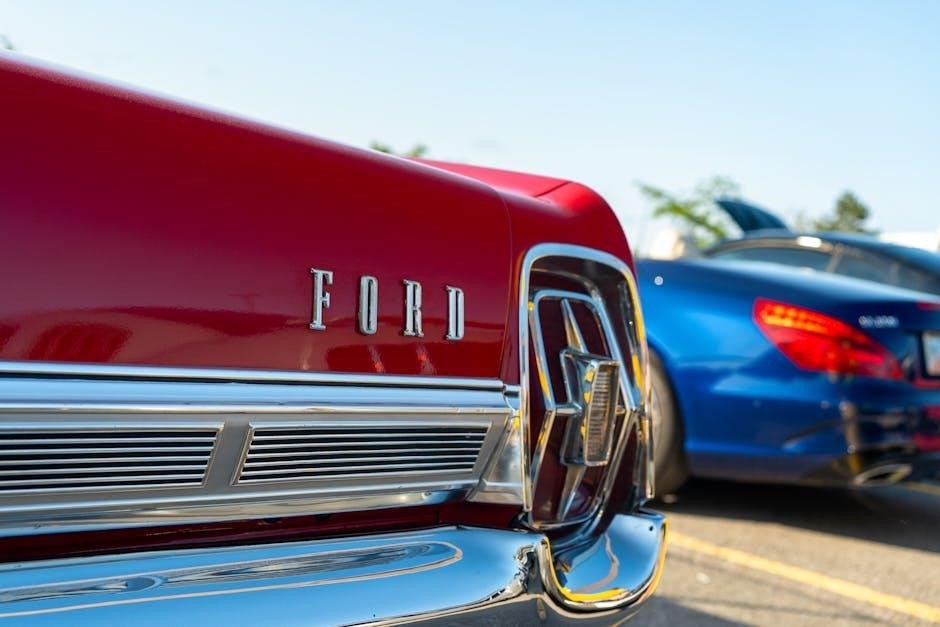
ford body builders guide
The Ford Body Builder’s Guide is an essential resource for builders, upfitters, and modifiers, offering comprehensive insights and specifications for customizing Ford vehicles․ It provides detailed technical information, practical advice, and best practices to ensure safe and efficient modifications, catering to both professionals and enthusiasts․ This guide is a cornerstone for anyone aiming to enhance or adapt Ford vehicles for specific needs, ensuring compliance with manufacturer standards and optimizing performance․ By following its guidelines, users can achieve durable, reliable, and high-quality results in their projects․
Overview of the Guide
The Ford Body Builder’s Guide is a detailed resource designed for professionals and enthusiasts modifying Ford vehicles․ It covers technical specifications, wiring diagrams, and installation guidelines to ensure safe and efficient upfitting․ The guide emphasizes compliance with Ford standards, offering insights into chassis modifications, weight distribution, and safety protocols․ It also provides best practices for body mounting, electrical systems, and maintenance․ Whether for commercial fleets or custom projects, this guide serves as a trusted handbook, enabling users to optimize vehicle performance while adhering to manufacturer recommendations․ It is a must-have for anyone aiming to enhance or adapt Ford vehicles effectively․
Importance of the Guide for Builders
The Ford Body Builder’s Guide is indispensable for builders, offering critical insights and specifications to ensure safe, efficient, and compliant vehicle modifications․ It provides detailed technical information, wiring diagrams, and installation guidelines, essential for maintaining Ford’s quality and safety standards․ Builders rely on this guide to avoid costly errors, optimize performance, and ensure reliability․ By adhering to its recommendations, professionals can achieve durable and high-quality results, making it a vital tool for both enthusiasts and commercial upfitters aiming to enhance Ford vehicles effectively while preserving their integrity and functionality․

Understanding the Ford Body Builder’s Guide
The Ford Body Builder’s Guide is a technical manual designed to assist builders and upfitters in modifying Ford vehicles safely and effectively․ It outlines specifications, wiring diagrams, and best practices to ensure compliance with Ford’s standards, helping to maintain vehicle integrity and performance during customization․
What is the Ford Body Builder’s Guide?
The Ford Body Builder’s Guide is a comprehensive technical manual designed to support builders, upfitters, and modifiers in customizing Ford vehicles․ It provides detailed specifications, wiring diagrams, and best practices to ensure safe and effective modifications․ The guide covers mechanical, electrical, and structural guidelines, helping users maintain vehicle integrity and performance while adapting Ford vehicles for specialized purposes․ It also includes resources for troubleshooting and compliance with manufacturer standards, making it an indispensable tool for professionals and enthusiasts alike․
Key Features and Benefits
The Ford Body Builder’s Guide offers detailed technical specifications, wiring diagrams, and safety guidelines to ensure modifications meet Ford standards․ It provides resources for troubleshooting common issues, ensuring compliance with safety regulations, and optimizing vehicle performance․ The guide includes CAD files, dimensional data, and installation tips, making it easier for builders to plan and execute custom projects․ By adhering to its recommendations, users can achieve professional-grade results while maintaining vehicle reliability and safety․ This comprehensive resource empowers builders to create tailored solutions, enhancing functionality and durability for a wide range of applications․

Planning Your Build
Planning your build involves assessing your needs, selecting the right Ford model, setting a budget, and utilizing Ford’s resources like manuals and CAD files for a safe and compliant project․
Choosing the Right Ford Model
Selecting the appropriate Ford model for your build is crucial․ Consider your intended use, whether for utility, recreation, or commercial purposes․ Models like the Transit, F-150, or Ranger offer durability and versatility․ Assess payload capacity, engine options, and upfitting possibilities․ Ensure the chosen model aligns with your project’s requirements and budget․ Ford’s range provides options for various applications, from lightweight payloads to heavy-duty tasks․ Review Ford’s specifications and resources, such as Body Builder Layout Books, to make an informed decision tailored to your needs and ensure compatibility with desired modifications․
Selecting the Body Type
Selecting the appropriate body type is vital for your project’s success․ Ford offers various body configurations, such as cutaway, chassis cab, and van bodies, each designed for specific applications․ Consider factors like durability, payload capacity, and ease of modification․ For instance, a chassis cab is ideal for upfitting with custom bodies, while van bodies suit cargo transportation․ Review Ford’s Body Builder Layout Book for detailed specifications and dimensions․ Ensure the chosen body type aligns with your intended use, whether for commercial, recreational, or utility purposes․ This step ensures optimal functionality and compatibility with your build goals․
Budgeting for Your Project
Budgeting is a critical step in any Ford body building project․ Establish a detailed budget by evaluating material costs, tools, and labor expenses․ Consider both initial and long-term expenses, such as maintenance and potential upgrades․ Prioritize spending based on your project’s goals, whether for functionality, aesthetics, or performance․ Research suppliers for competitive pricing and factor in unforeseen costs․ A well-planned budget ensures your build stays on track financially․ Regularly review and adjust your budget to accommodate changes or discoveries during the process․ Proper financial planning is key to a successful and stress-free project execution․

Technical Aspects of Body Building
Understanding the chassis, body structure, and weight distribution is crucial for safe and efficient body building․ Proper alignment ensures stability, while balancing weight optimizes performance and safety․
Understanding the Chassis
The chassis is the foundational structure of a vehicle, providing strength, stability, and support for the body and components․ In Ford vehicles, the chassis is designed to withstand various loads and stresses, ensuring durability and safety․ Proper alignment of the chassis is critical for optimal performance, as misalignment can lead to uneven weight distribution and reduced stability․ High-strength materials are often used to enhance rigidity while minimizing weight․ Understanding the chassis layout and its components is essential for body builders to ensure modifications are compatible and maintain the vehicle’s structural integrity․ This knowledge helps in making informed decisions during customization․
Body Mounting and Alignment
Proper body mounting and alignment are critical to ensure structural integrity, safety, and optimal performance․ Ford’s Body Builder’s Guide emphasizes precise alignment techniques to maintain even weight distribution and prevent undue stress on the chassis․ Misalignment can lead to uneven wear, reduced stability, and potential safety hazards․ Builders should use specialized tools and follow Ford’s specifications to secure the body correctly․ High-strength fasteners and mounting points are recommended to withstand various operational stresses․ Correct alignment also ensures proper functionality of vehicle systems, such as braking and steering, making it a cornerstone of successful body-building projects․
Weight Distribution and Safety
Proper weight distribution is vital for safety and performance in Ford vehicle modifications․ The guide underscores the importance of balancing loads to maintain stability and prevent hazards․ Uneven distribution can compromise braking efficiency and handling, increasing the risk of accidents․ Builders must adhere to Ford’s guidelines for payload capacity and axle ratios to ensure safe operation․ Regular inspections of mounting points and structural components are also essential to maintain integrity․ By prioritizing weight distribution and safety, builders can create reliable and durable vehicles that meet Ford’s high standards for performance and driver protection․

Tools and Resources
The Ford Body Builder’s Guide provides essential tools and resources, including wiring diagrams, manuals, and online portals, to assist in successful vehicle modifications and customizations․
Essential Tools for the Job
The Ford Body Builder’s Guide emphasizes the importance of having the right tools for modifications․ Motion-capture technology helps analyze employee movements for ergonomic designs․ CAD files and detailed wiring diagrams are provided for precise planning․ Specialized manuals, like the Peterbilt Medium-Duty Body Builder Manual, offer in-depth technical specifications․ Additionally, Ford Pro Upfitter resources and the Body Builder Advisory Service (BBAS) provide expert guidance․ These tools ensure modifications are safe, efficient, and aligned with Ford’s quality standards, helping builders achieve professional results in their projects․
Wiring Diagrams and Manuals
The Ford Body Builder’s Guide provides detailed wiring diagrams and service manuals to ensure safe and compliant modifications․ These resources include full schematics for electrical systems, helping builders avoid costly errors․ The guide also offers troubleshooting guides for common issues, such as faulty sensors or connectivity problems․ Additionally, Ford Pro resources provide access to CAD files and technical specifications, ensuring precise installations․ For complex projects, manuals like the Peterbilt Medium-Duty Body Builder Manual offer supplementary insights․ These tools are essential for achieving professional-grade results and maintaining vehicle reliability․

Safety Considerations
The Ford Body Builder’s Guide emphasizes strict adherence to safety protocols, ensuring compliance with industry standards․ Proper tools, equipment, and best practices are essential to prevent accidents and injuries․
General Safety Guidelines
Adhering to safety standards is crucial when modifying Ford vehicles․ Always wear protective gear, such as gloves and safety goggles, and ensure proper ventilation in the workspace․ Follow Ford’s recommended practices and manufacturer instructions for tools and equipment․ Regularly inspect vehicles for wear and tear to prevent unexpected failures․ Use approved lifting devices and ensure the vehicle is securely supported during repairs․ Avoid overloading vehicles beyond their specified capacity․ Keep flammable materials away from heat sources and maintain a clean, organized workspace․ Stay informed about potential hazards and updates from Ford to ensure a safe working environment․
Best Practices in the Workshop
Adopting best practices in the workshop ensures efficiency, safety, and high-quality results․ Always use Ford-approved tools and consult the latest manuals for specific instructions․ Maintain a clean, organized workspace to minimize errors and hazards․ Double-check all torque specifications and electrical connections to avoid costly mistakes․ Test all modifications thoroughly before final delivery to ensure reliability; Regularly update your knowledge on Ford’s latest technologies and guidelines․ Use genuine or recommended parts to maintain vehicle integrity․ Document all modifications for future reference and compliance checks․ By following these practices, you can achieve professional-grade outcomes and uphold safety standards․

Exterior Modifications
Exterior modifications enhance both aesthetics and functionality, focusing on aerodynamics, advanced materials, and weight reduction․ These upgrades improve performance, durability, and style, tailored to specific needs and preferences․
Body Styling and Aerodynamics
Body styling and aerodynamics play a crucial role in enhancing vehicle performance and efficiency․ The Ford Body Builder’s Guide provides expert tips on optimizing exterior designs, including aerodynamic tweaks to reduce drag and improve stability at high speeds․ Builders can explore advanced materials and techniques to create sleek, functional body styles that not only elevate visual appeal but also contribute to better fuel efficiency and handling․ Whether for racing, off-road adventures, or everyday driving, these modifications ensure a perfect balance between form and function, aligning with Ford’s commitment to innovation and excellence․
Advanced Materials and Techniques
The Ford Body Builder’s Guide highlights the use of advanced materials and cutting-edge techniques to enhance vehicle performance and durability․ Lightweight yet robust materials, such as carbon fiber and high-strength steel, are recommended to improve strength-to-weight ratios․ Modern manufacturing techniques, including 3D printing and laser welding, enable precise and efficient body construction․ These innovations not only reduce production time but also ensure superior reliability and sustainability․ By adopting these advanced methods, builders can create customized bodies that meet rigorous standards while maintaining a focus on environmental responsibility and cost-effectiveness․ This section empowers builders to embrace futuristic approaches for superior results․

Interior Customization
Discover how to create personalized and functional interiors tailored to specific needs․ The guide covers advanced materials, ergonomic designs, and comfort-enhancing features to elevate your Ford’s interior․ Expert tips ensure a perfect blend of style and utility, helping builders craft bespoke cabins that meet individual preferences and requirements․ This section is your gateway to transforming the inside of your Ford into a space that combines innovation, comfort, and practicality seamlessly․
Designing the Interior Space
Designing the interior space involves balancing functionality, comfort, and aesthetics․ The Ford Body Builder’s Guide provides insights into optimizing cabin layouts, ensuring ergonomic design and material selection․ Builders can explore advanced techniques for customizing seats, dashboards, and storage solutions while maintaining safety and comfort․ The guide emphasizes the importance of spatial planning to accommodate specific needs, whether for passenger comfort or cargo efficiency․ By adhering to Ford’s design principles, builders can create interiors that are both practical and visually appealing, tailored to individual preferences and requirements․ This section is a valuable resource for crafting bespoke interiors that enhance user experience․
Installing Custom Features
Installing custom features requires careful planning and execution to ensure compatibility and functionality․ The Ford Body Builder’s Guide offers detailed instructions for integrating aftermarket components, such as infotainment systems, lighting, and storage solutions․ Builders can leverage Ford’s specifications to ensure seamless installation while maintaining vehicle safety and performance․ The guide emphasizes the importance of using genuine Ford parts and adhering to electrical and mechanical guidelines․ By following these recommendations, custom installations can enhance the vehicle’s utility and aesthetic appeal without compromising its integrity․ This section provides a roadmap for achieving professional-grade results in custom feature integration;

Advanced Topics
Explore advanced modifications like suspension upgrades and engine performance enhancements․ These topics cover precision tuning and high-performance components to elevate your Ford vehicle’s capabilities and driving experience․
Suspension Upgrades
Suspension upgrades are a popular modification for Ford vehicles, enhancing both on-road handling and off-road capability․ Key components like coilovers, sway bars, and lift kits can significantly improve stability and responsiveness․ For enthusiasts, upgrading to performance suspension systems allows for better cornering and reduced body roll․ Heavy-duty options, such as those designed for Ford trucks, provide increased durability for towing or hauling․ When modifying, ensuring compatibility with your vehicle’s make and model is crucial․ Always follow Ford’s guidelines and consider professional installation to maintain safety and optimal performance; These upgrades can transform your Ford into a powerhouse for any driving scenario․
Engine Performance Enhancements
Engine performance enhancements are a key focus for Ford enthusiasts and builders, offering significant power and efficiency gains․ Popular upgrades include aftermarket air filters, performance exhaust systems, and ECU tuning, which optimize engine output․ The Ford Barra engine, known for its reliability and power potential, is a favorite among tuners․ Additionally, advanced materials and techniques, such as engine swaps and lightweight components, further enhance performance․ Always ensure modifications align with Ford’s specifications to maintain reliability and warranty compliance․ Consulting Ford’s official resources and expert mechanics is crucial for achieving optimal results safely and effectively․

Maintenance and Troubleshooting
Regular maintenance is crucial for extending vehicle life and performance․ Troubleshooting common issues early prevents costly repairs․ Follow Ford’s guidelines for inspections, diagnostics, and fixes․
Regular Maintenance Tips
Regular maintenance ensures optimal performance and longevity of your Ford vehicle․ Start with routine oil changes, tire rotations, and battery checks․ Inspect brakes and fluids regularly․ Keep the air filter clean to improve fuel efficiency․ Follow Ford’s recommended service intervals for specific components․ Address any warning lights promptly․ Properly secure the body and chassis after modifications․ Refer to the Ford Body Builder’s Guide for detailed schedules and procedures tailored to your vehicle’s specifications․ Consistent upkeep prevents major issues and keeps your build running smoothly for years to come․
Common Issues and Solutions
Common issues faced by Ford vehicle builders include timing belt failures, electrical system malfunctions, and sensor-related problems․ Regular inspection of belts and hoses can prevent sudden breakdowns․ For electrical issues, ensure all connections are secure and consult wiring diagrams․ Sensor malfunctions often require recalibration or replacement․ Addressing these problems early prevents costly repairs․ Refer to the Ford Body Builder’s Guide for troubleshooting steps and manufacturer-recommended solutions․ Proper diagnostics and timely maintenance are key to resolving issues effectively and ensuring reliable vehicle performance․ Always follow Ford’s guidelines for repairs to maintain warranty validity and safety standards․

Leave a Reply
You must be logged in to post a comment.